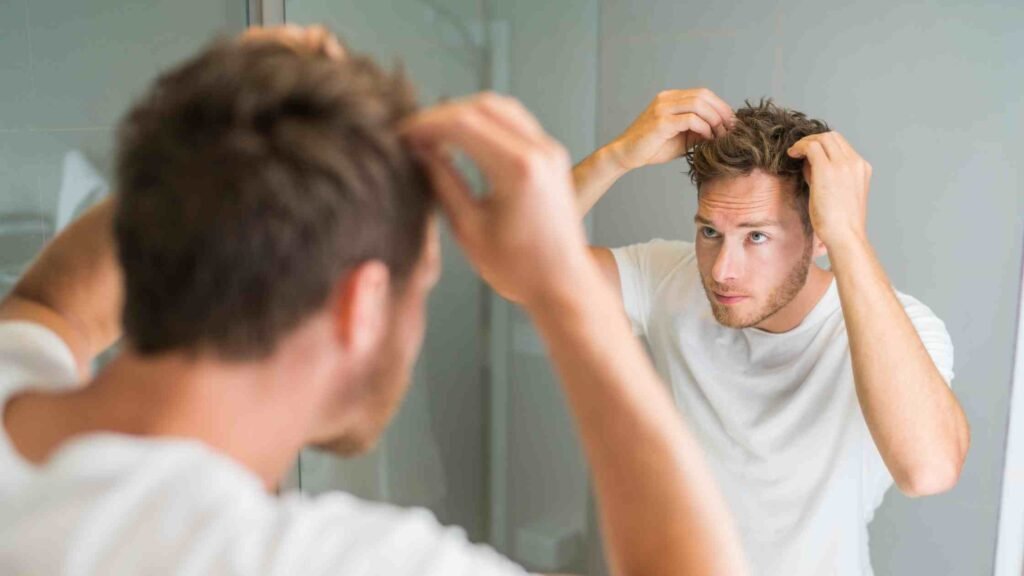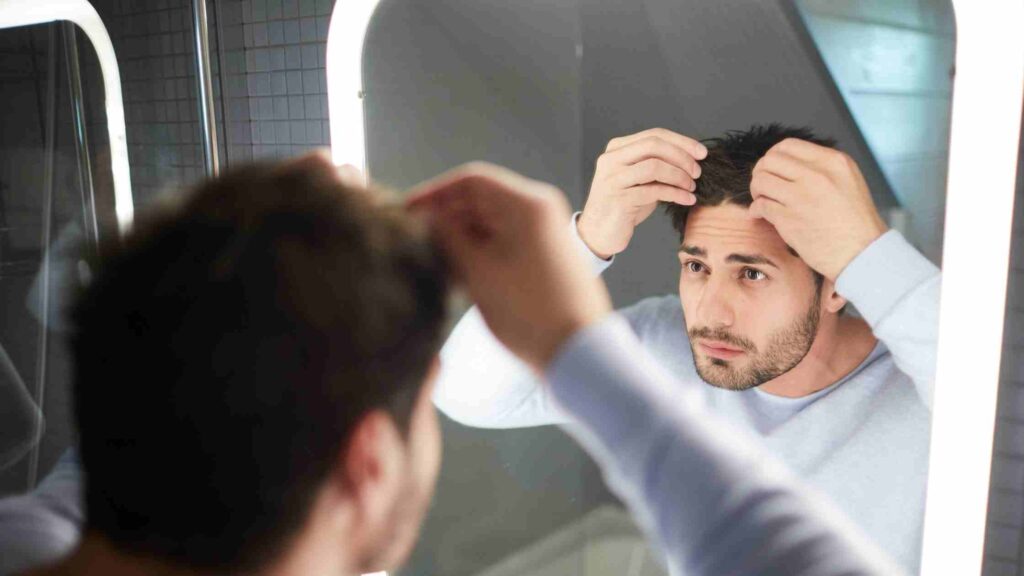Millions of men deal with the harsh reality of going bald, even after the fact that hair typically lives for around five years. Adults generally lose 50 to 100 hairs every day that regrow with time. But the irony is that with male pattern baldness, stray hairs never come back, and gradually, small hair-free patches appear.
Generally, this condition takes time to develop. However, since there is no specific age for losing hair, some people hit the reality of male pattern baldness early in their lives and define themselves as bald.
If we compare average hair loss and male pattern baldness hair loss, we will understand the difference between both. Men between 20 to 50 start losing scalp hair. And if it is male pattern baldness, they will experience 95% of hair loss until the maximum age range.

As the term suggests, male baldness is a specific pattern of losing hair that starts in different areas, especially the temple and the crown of the head.
This article will discuss the causes of male pattern baldness and the best possible treatment modalities to treat male pattern baldness. Read until the end.
Why Is It Called Male Pattern Baldness?
The condition for which male pattern baldness occurs is known as androgenetic alopecia. It is a common form of hair loss in both men and women. But in men, this condition is known as male baldness since the hair is lost in a well-defined pattern beginning above the temples. Over time the hairline forms a characteristic M shape, and gradually, the hair at the crown also thins, progressing to partial or complete baldness.
Read more about What Is Scalp Folliculitis- Symptoms, Treatments, Prevention and More to Know.
The pattern of hair loss is different in women and men. In women, hair thins all over the head without receding the hairline. And androgenetic alopecia doesn’t lead to total baldness in women.

What Are The Causes Of Male Pattern Baldness?
Losing 50 to 100 years every day is a common phenomenon. Hair loss is not even noticeable since the new hair also regrows simultaneously. But baldness occurs when new hair does not replace the lost hair. Hair loss can be related to one or more of the following factors:
- Heredity: The most common cause of hair loss is a family history of losing hair with aging. Androgenic alopecia is a condition that is hereditary and causes male pattern baldness and also female pattern baldness. It generally occurs in a predictable pattern with a receding hairline, bald spots in men, and thinning hair along the crown of the scalp in women.
- Medical Conditions And Hormonal Changes: A number of medical conditions cause permanent or temporary hair loss. Women experience excessive hair loss after childbirth, during menopause, and if they have thyroid problems. Alopecia areata is an immune system-related medical condition that causes patchy hair loss alongside scalp infections and a hair-pulling disorder called trichotillomania.
- Medications: Certain medications cause the side effect of hair loss, especially the drugs that are used to treat arthritis, cancer, depression, high blood pressure, and heart problems. Alongside medications, some supplements also can cause hair loss.
- Radiation Therapy: If any medical condition needs radiation therapy to your head, your hair may not grow back the same as it was before.
- Stress: Many people experience thinning of hair for several months after they undergo a stressful event. However, this type of hair loss is temporary.
- Hair Treatments: Excessive heat styling or pulling your hair tight to make pigtails can cause hair loss called traction alopecia. Hot oil treatments and permanent hair treatments can also cause hair loss. Furthermore, hair loss could be permanent if scarring occurs during those treatments.
Read more about Dandruff Treatment In Hyderabad
How To Identify Male Pattern Baldness?

Androgenic alopecia or male pattern baldness is quite common in Asian men. Therefore if you are noticing that your hair is thinning lately, you must be wondering if you are experiencing male pattern baldness. This type of badness occurs slowly over many years, and men between 40 to 50 years are more at risk of male pattern baldness.
But sometimes, it is difficult to understand whether hair loss is permanent since losing hair is a daily occurrence. Those hairs often come back on their own without causing any permanent pattern or baldness. However, we will tell you how to identify if you are gradually accumulating male pattern baldness so that you can sketch out your plan of action early.
- You Will Notice Gradual Thinning Of Hair On The Top Of Your Head: If anyone in your family, friend circle, or office has noticed that your hair is thinning at the crown, you must be mindful of the same. If you are at the early stages of male pattern baldness, you might notice some patchiness at the crown, and your hair will lose volume. Once you reach the later stages, your scalp is visible through your hair.
The crown of your head is the most common spot for hair loss. You also must check if thinning of hair started at your forehead and working its way backward. In male pattern baldness, the hairline recedes in an M shape. And if that is happening, this is the telltale sign that male pattern baldness is hitting you soon.
- You May Get Circular Patchy Bald Spots: In many cases, it can also happen that the front of the hairline is excellent, but if you grab a mirror and move it all around your head, you will find thinning or balding areas, especially on the top of your head and near the back of your head. At the early stage of male pattern baldness, those patches look a little thin, but in later stages, they would gradually expose your scalp.
In male pattern baldness, hair loss happens gradually, and it can take a long time to notice that you are losing excessive hair. Therefore, if you are unsure, you can ask your family member or friend to look at your hair.
- You Might Find Hair On Your Pillowcases And Hair Brush: Losing some hair every day is a normal thing since we rest assured that those hairs will grow right back. But that is not the case in aggressive male baldness because the sufferer may notice excessive hair loss and no sign of regrowth.
Read more about Minoxidil Topical Solution For Hair Loss & Its Uses, Side Effects
Soon after waking up, if you pay a little attention to your pillowcase and brush to find how much hair you lose every day, you will be able to identify if you are suffering from male pattern baldness. If you lose more than a few dozen hairs daily, be sure that male pattern baldness has affected you.
- You Feel Pain When Your Hair Falls Out: Though it is not common in every man suffering from male pattern baldness, some people experience itchiness or pain when they lose hair. It mostly happens with people suffering from alopecia. It can also cause them red and flaky bumps on their scalp that cause pain. And if you notice something like that, it is necessary to check with your doctor as they will be able to prescribe you specific medication or tell you if it is male pattern baldness.
Read more about PRP for Hair Loss: Does it Work, and Is It Safe?
What Are The Best Possible Treatment Modalities To Treat Male Pattern Baldness?
Medical science is so advanced now that it has one or more solutions to a problem. Even before you start suffering from any condition, the medicines and treatment options preexist.
Therefore, the first thing you need to do after addressing male pattern baldness is to stop worrying because many treatment options are available to help you deal with the situation. However, if you are not feeling good about it or want to talk your heart out, you can at any point in time consult with a psychotherapist who will help you gain confidence and reassure you that everything is going to be all right.
Now take a deep breath, hold and release because we will tell you about so many treatment options for male pattern baldness that you probably have never imagined. Understand the mechanism of every treatment better so that if you have to choose one treatment, you can do that with adequate information.

Over-The-Counter And Prescription Medications
Many FDA-approved medications are available over the counter to treat male pattern baldness.
- Minoxidil is the first we will talk about when it comes to over-the-counter medications for male pattern baldness. This content is available in liquid or foam form. And the patient must apply it on the scalp twice daily to promote hair growth and prevent further hair loss. Minoxidil might take up to 6 months to bring visible results. However, the result also depends upon proper application dosage and the unique condition of one patient from others.
- Finasteride is a prescription medication available in a pill form that patients suffering from male pattern baldness can take daily. But remember, it is only available when your doctor prescribes this medicine. According to FDA, this medicine takes at least three months of daily use to see results.
Read more about Minoxidil Topical Solution For Hair Loss & Its Uses, Side Effects
However, from both the Minoxidil and Finasteride medicines, it is better to expect results after one year, but you need to keep taking them to maintain the benefits.
Hair Transplants
A hair transplant aims to restore hair growth in the scalp areas where it is limited or absent of hair regrowth. Hear transplant is a viable and effective treatment for male pattern baldness, but this treatment cannot stop future hair loss. Therefore follow-up treatments are recommended to achieve lasting results.
During a hair transplant, the surgeon removes the follicles from an area of the hair, preferably the back of the head. The area from which the hairs are collected is the donor area. The follicles collected are then implanted into tiny slits of the affected area on the scalp.
There are two types of hair transplants:
Follicular Unit Strip Surgery: In this procedure, the surgeon removes a strip of skin from the donor area and then closes that incision with stitches. The surgeon then uses a microscope and separates the donor skin into tiny follicular units containing several hair follicles. Those follicles are then inserted into the desired area.
Follicular Unit Extraction: The surgeon uses a tiny punch tool to remove the follicles from the donor area. This process might lead to some scarring, but those scars are less noticeable, and the person does not require any stitches.
Read more about Best Non-Surgical Treatments for Hair Loss
Both techniques are proven effective but can achieve different results in different cases. According to an article published in 2019, Follicular Unit Extraction requires more skill and takes more time than Follicular Unit Strip Surgery. However, Follicular Unit Extraction can produce better results if the surgeon has years of experience in this technique.
In a hair transplant, the head’s back or side are considered donor areas. However, the surgeon may also take skin from the back, chest, and chin since they are proven effective. In many cases, a patient’s body hairs are used if they don’t have much hair on the back or sides of their heads.
Many studies have found that taking body hair is more time-consuming than choosing a donor area on the back of the head or the side. It also requires more skill. Another study reported that the body and beard are excellent sources for hair transplants.
The success rate of hair transplant is above 80%, and 8 out of 10 people said they are satisfied after undergoing follicular unit extraction treatment.
Platelet-Rich Plasma Treatment
Platelet-rich plasma injections are another most common treatment modality for male pattern baldness. These injections are gaining popularity for treating hair loss problems. Initially, those injections were used for various conditions, including sports injuries.
In platelet-rich plasma treatment, the patient’s platelets accelerate hair growth in specific areas. There are two elements in platelet-rich plasma: plasma and platelets. Plasma is the liquid portion of the blood, and platelet is the blood cells that play a pivotal role in healing throughout the body. Platelets have extraordinary clotting abilities and contain growth factors that trigger cell production and stimulate tissue regeneration.
In platelet-rich plasma, more platelets are present compared to general blood. To create platelet-rich plasma, clinicians collect a blood sample from the patient and then place it into a device for centrifugation. The device rapidly spins the sample and separates different components of the blood.
The platelet-rich plasma is then collected in syringes and injected into the target area. In many cases, clinicians use ultrasound to guide the injection to increase the concentration of specific hormones and bio proteins called growth factors to accelerate regrowth.
PRP, or platelet-rich plasma treatment in male pattern baldness, has proven to be highly effective since it can prevent hair loss and promote new hair growth. Patients who undergo hair transplants may also benefit from PRP injections. However, your surgeon me combine both treatments for better results.
Laser Treatment
Now you cannot deny that no matter the problem related to your hair or skin, laser therapy has at least some treatment for everyone. Though we commonly know laser therapy for removing body hair, it is also becoming increasingly popular for hair loss. Men suffering from receding hairline, people suffering from general thinning of hair, or even male and female pattern hair loss can be treated with laser therapy.
In laser therapy, for male pattern baldness, a low level of laser is used to stimulate hair follicles to grow fuller and thicker hair. This safe and non-invasive clinically proven treatment is commonly known as red light therapy. In this treatment, powerful clinical strength laser devices are used to irradiate photons into the human tissues and allow them to absorb them, especially the weaker cells, to restore their strength.
In laser therapy, the cells are found to regain their functionality and return to their normal process of growing hair. Low-level laser therapy also increases blood flow to the scalp to add new hair growth and maintain existing her. Doctors often assist with low-level laser therapy with Minoxidil to treat male pattern baldness.
How To Prevent Male Pattern Baldness?
Prevention is better than cure. But is that true in the case of male pattern baldness? Since it is proven that male pattern baldness is a hereditary problem, when people with a background of male pattern baldness in the family may accumulate the problem during their teenage, is it possible to prevent it?
Some lifestyle habits associated with hair loss must be stopped to slow the hair loss. What are those lifestyle changes you can embrace?
Quit Smoking: If you are a heavy smoker, you probably are well aware of all the adverse effects of smoking. Alongside harming your lungs, smoking is also associated with hair loss. In a study performed in 2020 among 1000 men, it was found that most men who smoked experienced some amount of hair loss compared to other participants who did not smoke. Quitting smoke decreases hair loss.
Massage Your Scalp: Scalp massage feels lovely and can also help you deal with excessive hair loss. A small study in 2016 among healthy Japanese men who received 4 minutes of scalp massage each day found that head massage leads to growing thicker hair.
Take A Balanced Diet: Diet is essential in treating any disease. If you are dealing with excessive hair loss, make sure that you include different vegetables, whole grains, fruits, and unsaturated fats in your diet. You also need to limit your intake of sweets. In a study established in 2019, it was found that protein-rich foods such as beans, green leafy vegetables, eggs, and rich Omega 3 fatty acids such salmon, mackerel, flax seeds, hemp seeds, egg yolks and walnuts and high protein foods like lean meats and seafood can help accumulate specific vitamins and minerals to promote hair growth.
Reduce Stress: Stress contributes to several body problems, including hair loss. If you are living a stressful lifestyle, try to reduce your stress with the following:
- Regular exercise
- Listening to music
- Yoga
- Meditation
- A complete sleep cycle
Conclusion
It is evident that when you suffer from male pattern baldness, you need at least one cosmetic treatment modality to deal with it better. However, the prevention methods can slow down the process of hair loss, but they cannot entirely stop your hair loss. When you experience sudden patchy hair loss, scaly skin, or rashes on your scalp, it is better to see a doctor and get tested if you are getting closer to male pattern baldness. I hope this article helped you know about male pattern baldness and determine the best treatment options.
